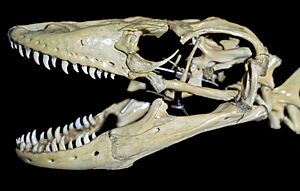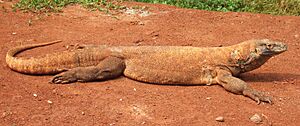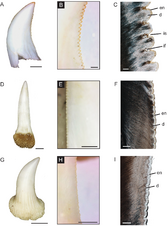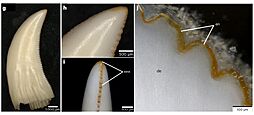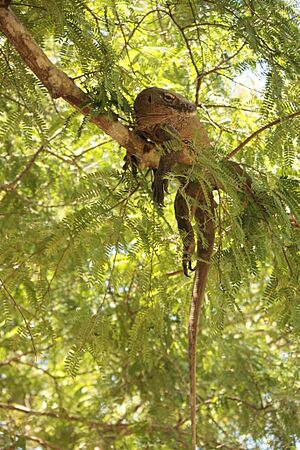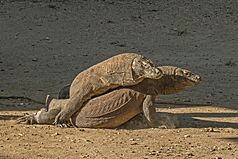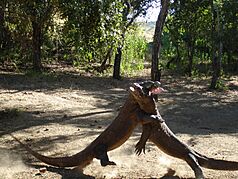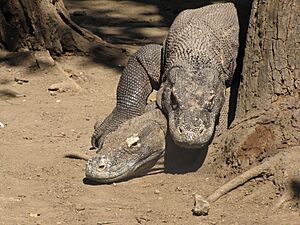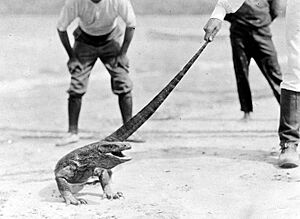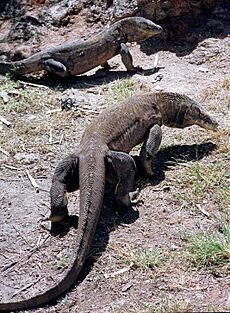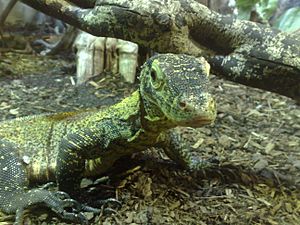Komodo dragon facts for kids
Quick facts for kids Komodo dragon |
|
|---|---|
 |
|
| Komodo National Park, Indonesia | |
| Conservation status | |
| Scientific classification | |
| Genus: |
Varanus
|
| Species: |
komodoensis
|
 |
|
| Komodo dragon distribution | |
The Komodo dragon (Varanus komodoensis), also known as the Komodo monitor, is a giant lizard. It belongs to the monitor lizard family. These amazing reptiles are endemic, meaning they live only on a few Indonesian islands. These islands are Komodo, Rinca, Flores, Gili Dasami, and Gili Motang. Most of them live safely in the Komodo National Park. It is the biggest living lizard species on Earth! Males can grow up to 3 m (10 ft) long. They can weigh as much as 150 kg (330 lb).
Because they are so big, Komodo dragons are apex predators. This means they are at the top of their food chain. They have a big impact on the ecosystems where they live. They hunt by surprising their prey. Their prey includes invertebrates (animals without backbones), birds, and mammals. It is unusual for reptiles, but Komodo dragons sometimes hunt in groups. Their main food is the Javan rusa (a type of deer). They also eat carrion (dead animals). Very rarely, Komodo dragons have attacked humans.
Komodo dragons mate between May and August. Females lay their eggs in September. They often lay up to 20 eggs at a time. They might use an old megapode (a bird that builds large nests) nest. Or they might dig their own hole. The eggs take seven to eight months to hatch. This usually happens in April when there are lots of insects for the babies to eat. Young Komodo dragons are small and must be careful. They live in trees to stay safe from danger. This includes adult Komodos that might eat them. To protect themselves, young dragons sometimes roll in animal droppings. It takes them about 8 to 9 years to become adults. They can live for about 30 years.
Scientists from Western countries first learned about Komodo dragons in 1910. Because they are so big and look fierce, they are popular in zoos. In their natural homes, the areas where they live have gotten smaller. This is due to human activities. Climate change might also reduce their habitat even more. This is why they are listed as Endangered by the IUCN Red List. This list shows animals at risk. They are protected by Indonesian law. The Komodo National Park was created in 1980 to help keep them safe.
Contents
- How We Discovered Komodo Dragons
- What's in a Name?
- Where Do Komodo Dragons Come From?
- What Komodo Dragons Look Like
- Amazing Teeth
- Super Senses
- How Komodo Dragons Live
- Diet
- Reproduction and Life Cycle
- Komodo Dragons and People
- Protecting the Dragons
- Komodo Dragons in Zoos
- Interesting Facts About Komodo Dragons
- See Also
How We Discovered Komodo Dragons
Europeans first heard about Komodo dragons in 1910. People were talking about a "land crocodile" on the Indonesian islands. Lieutenant van Steyn van Hensbroek, a Dutch government worker, investigated these stories. The dragons became famous after 1912. This was when Peter Ouwens, a museum director in Java, wrote about them. He had received a photo, a skin, and two dragon specimens.
The first live Komodo dragons in Europe were shown at the London Zoo in 1927. A scientist named Joan Beauchamp Procter studied these dragons in the zoo. She was one of the first to watch their behavior closely. She shared what she learned in 1928.
In 1926, W. Douglas Burden led a trip to Komodo Island. His main goal was to study these lizards. He brought back 12 preserved dragons and two live ones. This adventure even inspired the famous 1933 movie King Kong! Burden also gave them the popular name "Komodo dragon." You can still see three of the dragons he collected at the American Museum of Natural History.
The Dutch government quickly realized there were not many Komodo dragons in the wild. So, they stopped hunting them for sport. They also limited how many could be collected for science. During World War II, trips to study them stopped. They started again in the 1950s and 1960s. Scientists studied how Komodos eat, reproduce, and control their body temperature. In 1969, the Auffenberg family spent 11 months on Komodo Island studying them. Walter Auffenberg and his assistant Putra Sastrawan caught and tagged more than 50 Komodo dragons to learn more.
The Auffenbergs' research was very important. It helped people learn how to care for Komodo dragons in zoos. Since then, other scientists like Claudio Ciofi have continued to study these amazing animals. This helps us understand them even better.
What's in a Name?

Scientists sometimes call the Komodo dragon the Komodo monitor or the Komodo Island monitor. But these names are not used much. The local people on Komodo Island have their own names for it. They call it ora, buaya darat (which means 'land crocodile'), or biawak raksasa (which means 'giant monitor').
Where Do Komodo Dragons Come From?
Scientists studied the Komodo dragon's mitochondrial DNA. This is a part of their cells that holds genetic information. They found that the Komodo dragon's closest living relative is the Australian lace monitor. They share a common ancestor. This ancestor split off from the family line of the crocodile monitor found in New Guinea. A study in 2021 suggested that long ago, the ancestors of Komodo dragons even mated with the ancestors of some Australian sand lizards.
Fossils show that Komodo dragons used to live in Australia! These fossils are as old as 3.8 million years. The most recent Australian fossils are about 330,000 years old. Back then, they lived alongside an even bigger lizard. This lizard was called Varanus priscus (also known as megalania). It was the largest land lizard ever! The oldest Komodo dragon fossils found on the island of Flores are about 1.4 million years old. Scientists think some fossils found in Java and Timor might also be from Komodo dragons. This suggests they moved from Australia to Indonesia.
What Komodo Dragons Look Like
In the wild, adult Komodo dragons usually weigh about 70 kg (150 lb). Dragons in zoos often weigh more. According to Guinness World Records, an average adult male weighs 79 to 91 kg (174 to 201 lb). He is about 2.59 m (8.5 ft) long. An average female weighs 68 to 73 kg (150 to 161 lb). She is about 2.29 m (7.5 ft) long. The biggest Komodo dragon ever recorded in a zoo was 3.13 m (10 ft 3 in) long. It weighed 166 kg (366 lb). But that included a big meal in its belly! The largest one found in the wild was 3.04 m (10 ft) long. It weighed 81.5 kg (180 lb) without any food in its stomach. Some can weigh over 100 kg (220 lb) right after eating a large meal.
A Komodo dragon's tail is about as long as its body. They have around 60 sharp, serrated (saw-edged) teeth. Each tooth is up to 2.5 cm (1 in) long. These teeth are replaced often. Their saliva often looks bloody. This is because their gums get scraped when they eat. They also have a long, yellow tongue that is deeply forked, like a snake's.
Their skin is super tough! It is covered in armored scales. These scales have tiny bones called osteoderms inside them. These act like natural chain mail armor. The only parts of an adult's head without these bony bits are around the eyes, nostrils, mouth, and its parietal eye. This is a light-sensing spot on top of its head. Young Komodos do not have this armor. It develops as they get older. This likely protects them when they fight other adults over food or mates. This tough skin means it is not good for making leather.
Amazing Teeth
Komodo dragons have special teeth called ziphodont teeth. This means their teeth are flat from side to side. They are curved backwards. They also have serrated edges, a bit like a steak knife. Many ancient theropod dinosaurs had similar teeth! Young Komodo dragons that eat insects have teeth that are less curved and not as serrated.
A study in 2024 found that Komodo dragon teeth have an orange coating. This coating is rich in iron on their sharp edges and tips. This helps keep their teeth super sharp for cutting. Some other monitor lizards have this too, but not all. Their teeth are replaced very quickly, about every 40 days. They can have up to five replacement teeth ready for each spot in their mouth. This is similar to the crocodile monitor. Many other lizards only have one or two replacement teeth.
Super Senses
Komodo dragons have good senses, but they are a bit different from ours.
- Sight: They can see things as far as 300 m (980 ft) away. But their eyes only have cone cells (special cells for seeing color and detail). So, they probably do not see well at night. They can see colors. But they are not great at spotting things that are not moving.
- Hearing: They have one ear bone, called the stapes. This helps them hear sounds. They probably hear sounds between 400 and 2,000 hertz. Humans can hear from 20 to 20,000 hertz. People used to think they were deaf. But a zookeeper named Joan Procter trained one to come for food when she called it, even if it could not see her.
- Smell and Taste: Like many reptiles, Komodo dragons use their forked tongue to "taste" the air. They flick it out to pick up scent particles. Then they touch it to a special organ in the roof of their mouth. This organ is called the Jacobson's organ. This helps them find food. If the wind is right, a Komodo dragon might be able to smell carrion (dead animals) from 4–9.5 km (2.5–5.9 mi) away! They do not have many taste buds.
- Touch: Their scales have sensory plaques connected to nerves. These help them feel things. The scales around their ears, lips, chin, and the soles of their feet have even more of these touch sensors.
How Komodo Dragons Live
Komodo dragons like hot, dry places. You will usually find them in open grasslands, savannas, and tropical forests. But not high up in the mountains. They are ectotherms. This means they rely on the environment to control their body temperature. They are often called "cold-blooded." So, they are most active during the day. But sometimes they move around at night too. Komodo dragons are usually loners. They only get together to mate or eat. Interestingly, they can have different "personalities." Some are shyer than others, especially females. They can run very fast for short distances, up to 20 km/h (12 mph)! They can also dive up to 4.5 m (15 ft) deep. They are great tree climbers when they are young. They use their strong claws. To reach prey that is high up, a Komodo dragon might stand on its back legs. It uses its tail for balance. When they get older and bigger, climbing becomes difficult. So their claws are mostly used as weapons.
For shelter, Komodo dragons dig big holes. These holes are sometimes 1 to 3 m (3.3 to 9.8 ft) wide. They use their strong front legs and claws. Sleeping in these burrows helps them stay warm at night. It also means they do not have to spend as much time basking in the sun the next morning. During the hottest part of the day, they rest in the shade. They often hunt in the afternoon. Their resting spots are usually on ridges with cool sea breezes. They mark these spots with droppings. They keep them clear of plants. These spots are also good places to hide and wait for deer to pass by.
Diet
Komodo dragons are apex predators. This means they are at the top of the food chain. They are carnivores (meat-eaters). People once thought they mostly ate carrion (dead animals). But they often hunt live prey. They do this by hiding and then suddenly attacking. When an animal like a deer, pig, or buffalo comes close, the dragon will charge. It aims for the belly or throat.
They try to kill their prey quickly with powerful bites. These bites cause a lot of damage and blood loss. They can kill wild pigs in just a few seconds. Sometimes, if prey escapes after being bitten, it might get an infection from the wound. It could die later. Then, the dragon or other dragons might find and eat it.
Komodo dragons eat by tearing off big pieces of meat. They swallow them whole. They use their front legs to hold the food down. For smaller animals, like a goat, they can swallow them completely. This is because their jaws are very flexible. Their skulls can stretch. And their stomachs can expand. They usually do not eat the plants found in their prey's stomach. They produce a lot of reddish saliva to help the food go down. But it can still take a long time to swallow a big meal. It can take 15 to 20 minutes for a goat! Sometimes, a dragon will bash the food against a tree to push it down its throat. It can even knock the tree over! A small tube under their tongue connects to their lungs. So, they can still breathe while swallowing.
A Komodo dragon can eat up to 80% of its own body weight in one go! After a big meal, it will find a sunny spot to rest. The warmth helps it digest the food faster. If the food stays in its stomach too long, it could rot and make the dragon sick. Because they have a slow metabolism (how their body uses energy), big dragons can live on just 12 meals a year.
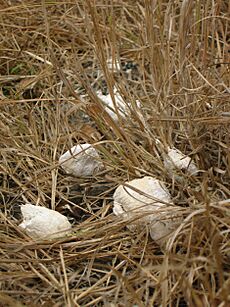
After digesting, the dragon coughs up a pellet. This pellet contains things it cannot digest, like horns, hair, and teeth. This pellet is covered in smelly mucus. The dragon then rubs its face on the ground or bushes to clean off the mucus.
When Komodo dragons eat together, there is an order. Bigger dragons usually eat before smaller ones. The biggest male is usually in charge. Smaller males show they accept his dominance with body language and hissing sounds. If two dragons are the same size, they might "wrestle" to see who is stronger. The loser usually backs off.
What Komodo dragons eat changes as they grow. Young ones eat insects, birds, bird eggs, and small reptiles. Bigger dragons (over 20 kg (44 lb)) prefer large animals. These include Javan rusa deer, wild pigs, and water buffalo. Very rarely, they have attacked humans. In the past, they sometimes disturbed shallow graves. This led villagers on Komodo Island to bury their dead in clay soil. They also covered graves with rocks. Long ago, during the Pleistocene epoch, Komodo dragons might have hunted a type of small elephant called Stegodon. This was before deer and pigs were brought to the islands by humans, about 7,000 to 10,000 years ago.
Komodo dragons drink water by sucking it into their mouths. They use a method called buccal pumping. They also use this for breathing. Then they lift their heads and let the water run down their throats.
Reproduction and Life Cycle
Komodo dragons mate between May and August. The eggs are usually laid in September. During mating season, male dragons fight each other for females and territory. They wrestle on their hind legs. The loser gets pinned down. Sometimes, males might even throw up or go to the bathroom before a fight! The winning male will then approach a female. He flicks his tongue to see if she is interested. Females can be quite feisty at first. They use their claws and teeth. So, the male has to hold her still during mating. Males also try to impress females. They do this by rubbing their chins on them, scratching their backs, and licking them. Mating happens when the male uses one of his two hemipenes (male reproductive organs) with the female's cloaca (a single opening for waste and reproduction). Interestingly, Komodo dragons might sometimes be monogamous. This means they form "pair bonds" with one partner. This is rare for lizards. Females also try to choose mates that are not closely related to them. This helps keep their offspring healthy.
Female Komodos lay their eggs between August and September. They might use different places. Some lay eggs in the large nests of orange-footed scrubfowl (a type of bird called a megapode). Some lay them on flat ground. Others lay them in hilly areas. Females often dig several fake nests. This helps confuse other dragons that might try to eat the eggs. Usually, only one female uses a nest. But sometimes two might share. A female lays about 20 eggs on average. The eggs take 7 to 8 months to hatch. Hatching is hard work for the baby dragons! They use an egg tooth (a sharp point on their snout) to break out of the shell. This egg tooth falls off soon after. After breaking free, the babies might rest in their shells for hours. Then they dig their way out of the nest. They are very small and helpless when they are born. A study of 16 baby dragons from one nest found they were about 46.5 cm long. They weighed around 105 grams.
Young Komodo dragons spend their first few years living in trees. This keeps them safe from danger. This includes adult Komodos. Sadly, about 10% of an adult dragon's diet can be young dragons. This might help adult dragons survive. This is because medium-sized prey animals are not very common on their islands. When young dragons come near a dead animal that adults are eating, they sometimes roll in animal droppings. Or they hide in the guts of the dead animal. This makes them smell bad. It might stop the adults from eating them. It takes about 8 to 9 years for a Komodo dragon to become an adult. They can live for up to 30 years.
Komodo Dragons and People
Attacks on humans by Komodo dragons are not common. However, they have happened. Sadly, a few have resulted in people dying. This has happened both in the wild and with dragons in zoos. Data from Komodo National Park between 1974 and 2012 showed 24 reported attacks on people. Five of these were fatal. Most of the people involved were local villagers who live near the park.
Protecting the Dragons
The Komodo dragon is listed as Endangered on the IUCN Red List. This means it is at very high risk of disappearing in the wild. Scientists, zoos, and the Indonesian government have known for a long time that these amazing animals are vulnerable. They face threats from nature and humans. To help protect them, Komodo National Park was created in 1980. This park covers islands like Komodo, Rinca, and Padar. Later, two more reserves, Wae Wuul and Wolo Tado, were set up on Flores island. This was to help save Komodo dragons.
Komodo dragons usually try to stay away from people. Young dragons are very shy. They will run and hide if a person gets within about 100 metres (330 ft). Older dragons will also move away if people get too close. But they might let you get a bit nearer before they do. If a Komodo dragon feels trapped, it might act aggressively. It could open its mouth wide, hiss, and swing its tail as a warning. If bothered further, it might attack and bite. While there are stories about Komodo dragons attacking people without reason, most of these are probably cases where the dragon was defending itself. True unprovoked attacks are very rare. They usually involve dragons that have lost their natural fear of humans.
Several things threaten Komodo dragons:
- Volcanoes and earthquakes
- Losing their homes (habitat loss)
- Fires
- Too much tourism in their areas
- Fewer prey animals because of poaching (illegal hunting)
- Illegal hunting of the dragons themselves
A big future threat is climate change. This could lead to aridification (land becoming drier) and sea level rise. These changes can damage the low-lying areas where Komodo dragons live. They do not usually live in the higher parts of the islands. Scientists predict that by 2050, climate change could reduce the dragons' suitable habitat by a lot. Possibly between 8% and 71%, depending on how much the climate changes. If we do not take action, dragons on Flores island could disappear completely. Even on Komodo and Rinca islands, their numbers could drop a lot. Taking quick action to slow down climate change is very important for saving these dragons. However, some scientists have different opinions about exactly how climate change will affect them.
It is illegal to buy or sell Komodo dragons or their skins internationally. This is because they are protected under CITES, an international agreement. Even so, people sometimes try to smuggle them. In March 2019, police in Indonesia caught a group trying to smuggle 41 young Komodo dragons out of the country. They planned to sell them for a lot of money (around US$35,000 each!). The dragons were likely smuggled from East Nusa Tenggara province.
In 2013, there were about 3,222 Komodo dragons in the wild. This number dropped slightly to 3,014 by 2015. On the big islands like Komodo and Rinca, their numbers stayed mostly the same. But on smaller islands like Nusa Kode and Gili Motang, their numbers went down. This was probably because there was less food for them. Sadly, Komodo dragons have disappeared from Padar Island. The last ones were seen there in 1975. It is thought they died out on Padar because the large animals they ate became scarce. This was likely due to illegal hunting.
Komodo dragons only live in a few places on the Wallacean Islands (a group of Indonesian islands). Scientists study them to understand how they have survived for so long. It seems their survival is due to a mix of things. These include being ectotherms, their special lizard biology, the type of places they live, and how humans have affected them.
Komodo Dragons in Zoos
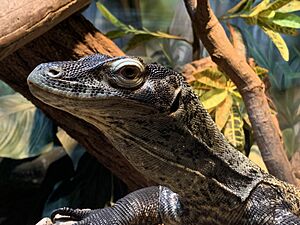
Komodo dragons are popular in zoos because they are so big and impressive. However, they are not very common in zoos. If taken from the wild, they can easily get sick. They also do not breed very easily in captivity. The first Komodo dragons in a US zoo were at the Bronx Zoo in 1926. But they did not live long. London Zoo got its first Komodos in 1927. Early on, Komodos in zoos often did not live very long. Important studies by Walter Auffenberg helped people learn how to take better care of Komodo dragons. They also learned how to breed them in zoos. The Surabaya Zoo in Indonesia has been very successful at breeding them since 1990. In 2022, they had 134 dragons! Many zoos around the world now have Komodo dragons. For example, in 2016, four dragons were moved from the Bronx Zoo to the Madras Crocodile Bank Trust in India.
Komodo dragons in zoos show interesting behaviors. Most become quite tame. They can even tell the difference between people they know and strangers. They have also been seen playing with things like shovels, cans, plastic rings, and shoes! This play does not seem to be related to hunting for food.
Even Komodo dragons that seem calm can suddenly become aggressive. This is especially true if a stranger enters their space. In 2001, a man named Phil Bronstein was seriously injured by a Komodo dragon at the Los Angeles Zoo. He had entered its enclosure with the keeper. He was bitten on his foot. The keeper had asked him to take off his white shoes and socks. This was because they were the same color as the white rats fed to the dragon. This might have excited it. Mr. Bronstein survived but needed surgery on his foot. This shows it is important to always be very careful around these powerful animals.
Interesting Facts About Komodo Dragons
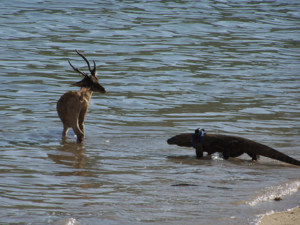
- For a long time, people thought Komodo dragon saliva was full of nasty bacteria. They thought this made their bites deadly. But research in 2013 showed that the bacteria in their mouths are pretty normal. They are similar to other meat-eating animals.
- Komodo dragons actually keep their mouths quite clean! After eating, they spend 10 to 15 minutes licking their lips. They also rub their heads in leaves to clean up. They do not have rotting food stuck in their teeth.
- Their bite is still very dangerous. It is a powerful slashing bite. Some scientists believe their saliva contains venom. This venom stops blood from clotting and affects the nerves.
- Scientists have found something amazing in Komodo dragon blood. It is a powerful substance that fights bacteria. It is a type of peptide (a small protein). They have even made a synthetic (man-made) version called DRGN-1. Early tests show DRGN-1 can kill bacteria that are resistant to many common medicines. It can even kill some fungi. It also seems to help wounds heal faster, even if they are infected. This could be very useful for human medicine one day!
- Here is something truly amazing: female Komodo dragons can sometimes have babies without a male! This is called parthenogenesis. When a female Komodo dragon reproduces by parthenogenesis, her eggs only get one chromosome from each pair. If an egg gets a Z chromosome and then doubles it, it becomes ZZ – a male. If it gets a W and doubles it (WW), the egg does not develop. So, only male babies are born this way.
See Also
 In Spanish: Dragón de Komodo para niños
In Spanish: Dragón de Komodo para niños
- List of largest extant lizards
- Komodo Indonesian Fauna Museum and Reptile Park



